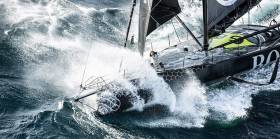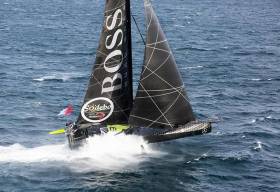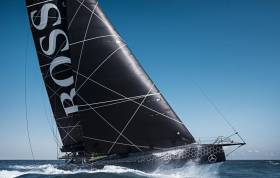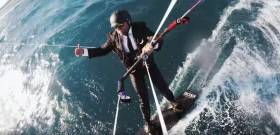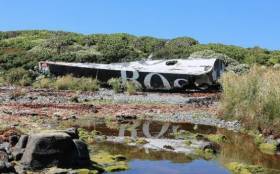Displaying items by tag: Alex Thomson
Nin O’Leary Aims Even Higher With Alex Thomson Fastnet Berth
It was the coolest thing so far in all of 2017's sailing. In the midst of the Royal Cork DinghyFest which he was organising, Nin O’Leary took off for just one day to skipper Adam Gosling’s new JPK 10.80 Yes! In the huge-fleet Round the Island Race writes W M Nixon. In such a turnout, winning overall by a few seconds is the norm. But young Nin did it in style, something like eight minutes clear, an astonishing performance.
It was a massive achievement which did no harm at all in distracting attention from another project brewing up in the O’Leary camp in as much secrecy as could be managed. The Vendee Globe 2020, no less. This is very serious stuff. This afternoon, Afloat.ie can reveal that the first public step has been taken on the campaign trail, with Nin signing up to race as co-skipper with Alex Thompson on Hugo Boss in the Rolex Fastnet Race on August 6th. Now that - that is super cool. For those still gasping, here’s the Press Release:
British skipper Alex Thomson will compete in the Fastnet Race with Irish sailor Nin O’Leary which starts on Sunday 6th August. Thomson, who finished second in the Vendee Globe earlier this year stated ‘I am looking forward to taking part in the Fastnet again and to have Nin as my co-skipper. It is great to be able to support the new generation of offshore sailors.’ O’Leary, a young, talent in offshore sailing has been training with the Alex Thomson Racing team this summer and assisted the team in preparations ahead of the Vendee Globe in 2016 where he completed over 1500nm onboard HUGO BOSS. O’Leary stated ‘I am thrilled about the opportunity to race with Alex and onboard HUGO BOSS.Alex has set the benchmark in offshore sailing and being chosen to co-skipper the boat with him is a huge honour and allows me to start the preparation for my own Vendee Globe campaign in 2020. We are looking forward to a great race together.’
Alex Thomson Talks Vendee Globe Race 2020
Two days after finishing second in the Vendée Globe, British skipper Alex Thomson is recovering well in the start and finish host town of Les Sables d’Olonne on the west coast of France. He has been enjoying family time, taking every chance to spend some hours with his young son and daughter in between resting and completing a whirlwind schedule of media interviews.
When he joined Vendée LIVE in French and English today, he enthralled a ‘standing room only’ packed house comprising local ‘Sablais’, French and international Vendée Globe fans, with his ready wit, his frank and full answers and his undimmed passion for the legendary solo non stop race around the world. Thomson confirmed today that he intends to do the race again in 2020, looking to add a win to his third and second places but only if he can put together a fully competitive programme. On a lighter note Thomson told how, the morning after finishing his gruelling 74 day race, he took his kids to the swimming pool of his hotel to be greeted in the water by his rival, race winner Armel Le Cléac’h who he had been racing head to head with him for 90 per cent of the 27,000 mile course. Before he moves forward with the next phase of his racing career, Thomson will take a holiday….sailing in the Caribbean.
The Hugo Boss skipper laughed: “My wife has booked our dream sailing holiday together in the Caribbean. She has promised we have double beds, flushing toilet and fridge, freezer and lots of beer and rum. We are off to do that.” Having now had a little time to discuss future Vendée Globe plans with his wife Kate and his core team, he is keen to complete the story with a win: “Third last time, second this time. It is obvious what we need to do. What I need to do is to have a competitive campaign to do it again and the level of commitment from my family, from my team, from my team’s families. It means we need the right funding, but the most important thing is the people and the very next thing is the funding.” Reviewing the emotional videos of his finish and return into the famous Les Sables d’Olonne channel, Thomson explained: “For me in the race I always feel it is very important not to think about the finish until it happens. Anything can happen right up until the finish line. Mike Golding lost his keel 50 miles from the finish. Even when I am 20 miles away, I am still not really telling myself I am about to finish. All the emotion, all the work you have put in, all the stress, it is not really over until that line. And then it just feels like the responsibility is lifted off your shoulders. I am not even sure you are really aware of the responsibility. Having to sleep with one eye open, you are constantly thinking of what can happen next.”
Of his ‘decompression’, his recovery since finishing he said: “It takes a few months to recover. I will be a few months in the gym. My gluteus maximus has turned to a gluteus minimus. I have got no quadriceps muscles any more. I am in pain walking around. Physically it is going to be lot of work. I am sleeping quite well. I normally sleep for only one or two hours for quite a long period after the race. I feel pretty exhausted. I really felt like the tank was empty this time. I actually have put weight on my stomach. My weight will have dropped though because you lose big muscles like your quads and your glutes, my legs are terrible, there is nothing there. One of the problems I did not tell people about is where the jib sheets come down through a block on the deck, the pulley where the rope does a 110 degree turn, stopped working about six weeks ago. And so I was dragging the ropes through the sheave. And I actually feel like my shoulder has moved forward in the socket.”
Speaking to Rich Wilson, the skipper of Great American IV, Thomson paid tribute to the American’s excellent energy generation systems, a combination of wind vane, hydrogenerator and solar panels which mean that he has barely used any diesel. “I used 200 litres of fuel,” said Thomson who fought energy generation issues almost all the way through his 2012-13 race, rebuilding hydrogenerators and struggling for long period with very limited energy, hence his choice to go ‘belt and braces’ with diesel this time: “I had a tiny solar panel and my hydrogenerator was a back up. Mainly we were using diesel. But if we do another one I would to do it with using zero fuel. I love what you are doing and particularly what Conrad is doing. I think we should be going around the world without using any fossil fuels.” And he expressed his belief that the Vendée Globe should remain open and inclusive: “I think one of the great things is the amazing characters. If it was not set up the way it is then we would not have a Rich Wilson, we would not have had an Enda, we would not have a Sébastien Destremau. I think if there were 30 of me and Armel it would be a bit boring. Nandor Fa is extraordinary. To have a man who designed his own boat, who built it himself and is in eighth place. I have a real soft spot for him.”
The use of foiling appendages is in its infancy in the IMOCA 60 class which the Vendée Globe is raced in. Thomson want to see the class make the right decisions in the immediate future, to continue to develop fast, safe boats but considering costs and speeds relative to non-foiling boats: “We have just scratched the surface. The foils on our boat and those on Banque Populaire are slightly different. We were slightly better downwind but we were not so good in other areas. It was not a golden ticket. But we did go a very long way in a very short period of time. We have got longer. Our version 2 foils broke within three days and, yes, there will be a version 3 in due course. But we need to look at the data and see what we can do. There is an annual general meeting of the class in April. That will decide what the rule is. What is important is that we have a rule. It does not matter what it is. I think we need to be careful not to have a rule which makes what we do quite inefficient and very expensive. Like the America’s Cup. When they designed the boats they did not want them to foil, but Team New Zealand found how to make them foil, but in a very inefficient and almost dangerous way. I think that is what we need to do with IMOCA. We need to think about the costs too. There are seven boats foiling and on average each boat building two sets of foils. These foils are costing three or four hundred thousand pounds a pair, plus the cases. We don’t want the gap between the well-funded teams and the other teams to be too big. There is a lot of work to do. I sit on the executive committee of IMOCA, Armel Le Cléac’h is on the team, and Jéremie (Beyou).”
Irish Influence Remains In Vendée Globe’s Final Hours
#VendéeGlobe - Despite Enda O’Coineen’s New Year mishap taking him out of contention, the battle for victory in the Vendée Globe retains a distinct Irish flavour.
Although he conceded yesterday that his chances of victory were slim – confirmed by the latest race update — Alex Thomson is still in hot pursuit of race leader Armel Le Cléac'h and Banque Populaire to clinch second place on the home stretch to Les Sables.
The route took Thomson’s record-smashing HUGO BOSS and the rest of the fleet just hours south of Cork Harbour, where the British skipper spent many formative years affirming a love of sailing that’s taken him to the peak of the sport.
His team boss at Alex Thomson Racing, Stewart Hosford, is also based in Cork, as previously reported on Afloat.ie.
“In the year that saw Ireland win an Olympic medal for sailing, and the first Irish entry to the Vendée Globe, it would be wonderful to see the team led by an Irishman win the globe’s most challenging race”, said Hosford earlier this week.
Other Irish connections were present earlier in the race, in the form of French yacht SMA — whose team director is a Corkonian, Marcus Hutchison – and the Japanese entry Spirit of Yukoh, managed by Dublin-born Tony O'Connor.
And while both boats have since retired, their contention remains a good omen for Ireland’s place in global sailing — and might influence greater Irish participation in the next Vendeé Globe in 2020.
Ireland & Cork Sailing On A High As Vendee Globe Hits World Target
Enda O’Coineen may have exited the Vendee Globe in dramatic fashion on New Year’s Day when, as he drolly put it, Kilcullen Voyager stopped stone dead as she zapped into the back of a Southern Ocean wave, but his enormous mast just continued straight on with an almighty crash as it broke off clean at the deck. But this ruthless race continues on its way, and there’s still much of very specific Irish interest in it as the leaders approach the finish. W M Nixon gives us his own take on it all, and then tells us a tale out of school about Irish involvement.
It has to be the oddest geography lesson ever provided. And it has to be the most unexpectedly energetic way of promoting a relatively unknown region of France which was formerly almost exclusively associated with a relaxed way of life.
Once upon a time, the Vendee was a place which you’d usually associate with the gentler things in life. Things like good food and summer wine enjoyed in a sleepy siesta lifestyle in gently dusty villages inland from some fine beaches, villages where life moves slowly under the kindly shade of many trees, in a latitude which is not so far south as to be overly hot in summer, yet not far enough north to experience harsh winters.
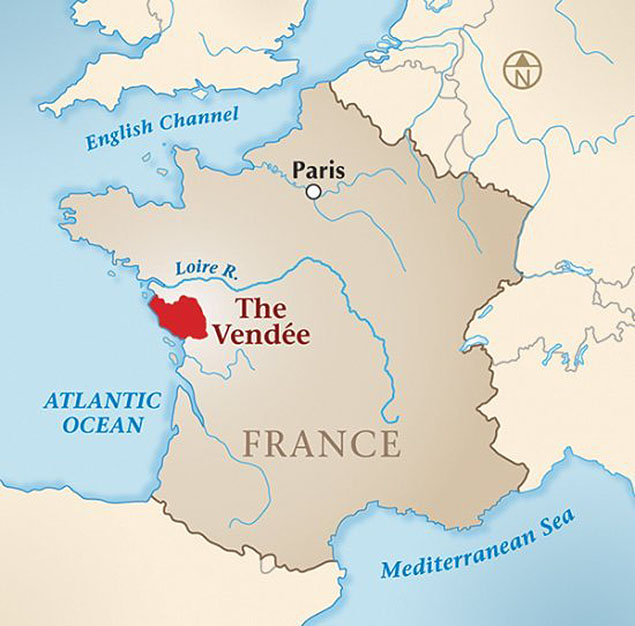 Little place that thinks big – France’s Vendee region has put itself firmly on the world map by sponsoring the Vendee Globe
Little place that thinks big – France’s Vendee region has put itself firmly on the world map by sponsoring the Vendee Globe
It’s about the size of an average Irish county. Yet right now, France’s modestly endowed Vendee region is being promoted as a place of world significance by extreme sportsmen taking part in a rugged sailing exercise with the most severe physical and life-threatening challenges, subsisting on a meagre diet which would rightly produce rioting in any self-respecting prison.
Welcome to the world of the Vendee Globe. That is, in the unlikely event that you aren’t already addicted to following it on a daily or indeed hourly basis. This still almost unbelievable round the world non-stop marathon continues to have an air of crazy novelty and enduring fascination, even though it was first staged in 1989.
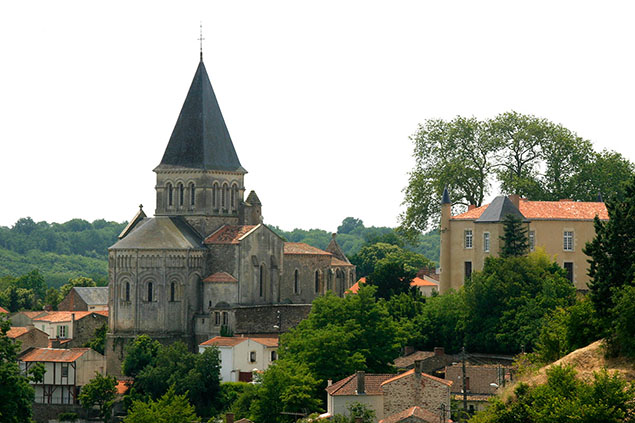 Peaceful countryside. Deep in the heart of the Vendee, the sea seems far away
Peaceful countryside. Deep in the heart of the Vendee, the sea seems far away
It boggles the mind to try and imagine the great French sailor Philippe Jeantot taking on the challenge of persuading the civil servants and politicians who run this relatively remote region of west France to permit, let alone sponsor, an event which is now utterly out on its own. Yet the regions of France quite rightly have an intense local pride. And if we in Ireland feel a tinge of envy at what they can achieve, just remember that last weekend it was announced that Wicklow Sailing Club had become the Mitsubishi Motors Club of the Year for 2017 thanks to their utter commitment to promoting the Round Ireland Race on a biennial basis, while at the same time continuing to function successfully as a club which caters for local sailing needs.
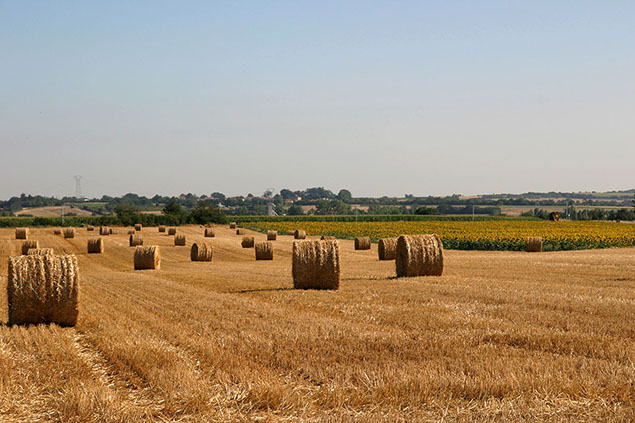 A summer cornfield in the Vendee is about as different as you can get…
A summer cornfield in the Vendee is about as different as you can get…
 ….from rounding Cape Horn in a rising gale. Yet both are linked through the world’s most challenging race
….from rounding Cape Horn in a rising gale. Yet both are linked through the world’s most challenging race
It’s something which is unusual in an overly-centralized country like Ireland, where all major decision are made in the capital, and in sailing you’d expect one of the main centres such as Cork Harbour or Dublin Bay or Belfast Lough to be the home of the Round Ireland race. But it is dogged little Wicklow which has won through, and 2016’s race fully justified their faith.
However, in the Irish context it is a local sailing club which is setting the pace. But in France, it is the regional administration which has been persuaded to pull off a remarkable coup. Looking at the scale and publicity which accompanies the Globe race, you’d assume it starts and finishes in a major centre such as Brest, or Lorient, or La Rochelle. Au contraire. The Vendee Globe starts and finishes in the very artificial sand-surrounded port of les Sables d’Olonne, set on a long sandy coast off which just about the only object of interest is the intriguing little Biscay island of Ile d’Yeu.
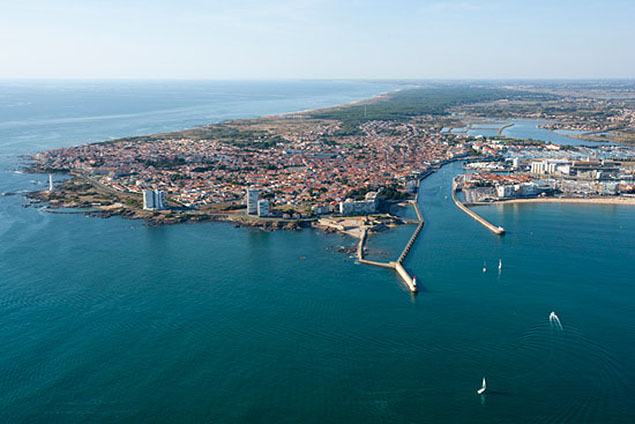 Les Sables d’Olonne, where the harbour is tucked in behind what used to be sand dunes
Les Sables d’Olonne, where the harbour is tucked in behind what used to be sand dunes
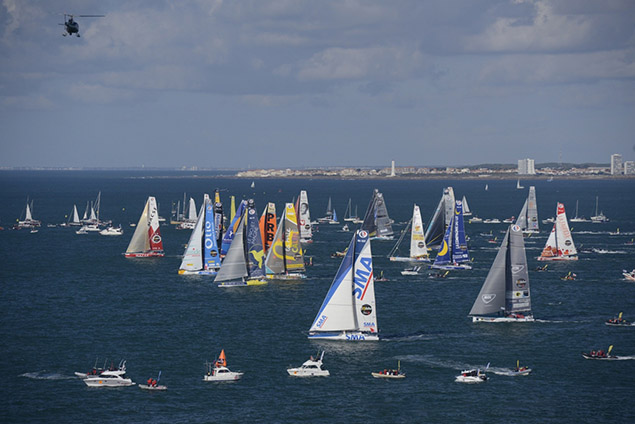 The start of the Vendee Globe 2016-2017
The start of the Vendee Globe 2016-2017
Yet despite the paucity of features of special interest along its sandy beaches, every three to four years sees Les Sables d’Olonne being swamped by hundreds of thousands of visitors when the Vendee Globe circus is in town. And this weekend, the focus sees the Race Headquarters move from their race-time base at the foot of the Eiffel Tower in Paris back to the quayside at Les Sables in anticipation of the finish, some time in the middle of next week, of the two fleet leaders.
Yesterday, gales on the Biscay coast prevented the re-installation of the super-tented Vendee Globe Village in Les Sables. But by today the command control should be broadcasting again on all media, and we can resume our daily doses of a fascinating event which is reaching its most crucial stage in an unexpected way.
For after a week in which severe storms have been sweeping most of Europe, a great big high pressure area is showing every sign of settling in over the southwest approaches to the Bay of Biscay right across the track which the two leaders – Armel le Cleac’h on Bank Populaire VIII and Alex Thompson closing up from 130 miles astern on Hugo Boss – will have to take to get to Les Sables.
C’est ridicule! The seas off northwest Spain - Galicia, Finisterre, whatever you want to call it – should be one of the stormiest places in the world in the latter half of January. Yet here it is, in an increasingly benign mood, with the final stages of the world’s breeziest race threatening to become a battle of the zephyrs.
 Enda O'Coineen and Stewart Hosford in Cork Harbour in 2015
Enda O'Coineen and Stewart Hosford in Cork Harbour in 2015
Under time-honoured traditional yacht racing tactics, all Le Cleac’h need to do is keep re-positioning himself so that he is directly between Thomson and the finish line. But these are not traditional yachts. Even in a zephyr, they can virtually create their own wind, and if the leader really does become so completely and utterly becalmed that he loses steerage way, the second-placed boat knows that his primary objective must be to maintain way even if it means actually heading away from the finish.
However, let’s face it, it is January, and it’s unlikely the total calm you might experience in high summer will ever settle in. That said, for le Cleac’h the situation is hugely challenging, for if there is one other skipper in the entire race who has the ability to pull off an audacious coup and snatch the lead, then it is 42-year-old Alex Thomson.
And in a sense, here in Ireland we can look on him as one of us. For five formative years of his childhood, he lived in the Crosshaven area, and his name can be found in the register of Templebreedy National School. His father Peter was a helicopter pilot on air-sea rescue duty, which meant that Alex was born in Bangor in North Wales as his father at the time was flying out of Anglesey, but then the move came to Cork airport, and the young Alex saw his first sailing off Weavers Point.
Sailing the seas of Cork at that time was young Stewart Hosford whose father Bill was one of the crew on Denis Doyle’s blue S&S designed Moonduster. Bill Hosford was also one of the consortium involved with Barry Burke in building the Ron Holland-desined Shamrrock racer-cruiser range, while for some added interest Bill and his wife Ann for ten years owned that deservedly renowned West Cork hostelry Mary Ann’s in the picturesque village of Castletownshend.
However, the challenge of life as an international banking executive drew young Stewart away from Cork, and he spent fifteen years in the City of London and another five in Edinburgh before the call of the sea returned, and he and his mates bought the Farr 65 Spirit of Diana in 2000 and linked up with the recent winning skipper in the Clipper Round the World Race, one Alex Thomson, to go racing. The rest is history.
 “Alex does the sailing and the stunts…..” A spot of keel-walking with Hugo Boss
“Alex does the sailing and the stunts…..” A spot of keel-walking with Hugo Boss
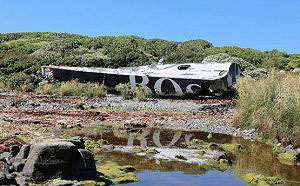 Even when things don’t go quite according to plan, somehow it still seems a success…
Even when things don’t go quite according to plan, somehow it still seems a success…
The synergy between the two men in creating a boat racing organization is extraordinary. Even though Stewart is now based back in Cork, life is totally peripatetic as he fulfills the role of CEO of Alex Thomson Racing, while Alex does the sailing and the stunts, and Sir Keith Mills is the third corner of a remarkable triangle for creating success.
The well-established link-up with Hugo Boss completed the package, and while on occasion things have gone spectacularly wrong, there’s something about an Alex Thomson Racing failure which makes it into a success. The man himself has a superhuman dedication and determination, and an ability to think completely outside the box, which makes their involvement in any event add greatly to its success.
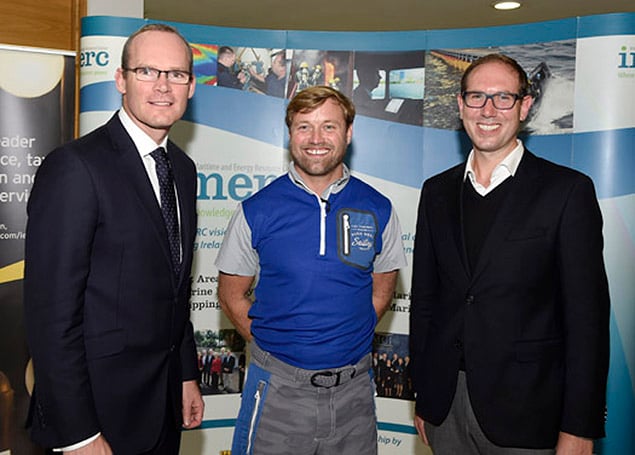 The then Minister for the Marine Simon Coveney with Alex Thomson and Stewart Hosford at a press briefing to put forward some proposals for developments on Cork Harbour
The then Minister for the Marine Simon Coveney with Alex Thomson and Stewart Hosford at a press briefing to put forward some proposals for developments on Cork Harbour
Most of us have lost count of how many different boats called Hugo Boss there have actually been, but there’s no doubt the current boat – after some setbacks which would have rebuffed a lesser squad – has evolved into on of the most formidable racing machines on the planet.
So even though it’s unlikely she’ll get starboard tack all the rest of the way to the finish in order for her lack of a starboard foil not to be a disadvantage, Hugo Boss racing has now reached such a level of attention that any outcome is ultra-newsworthy.
But though we talk of the Alex Thomson Racing challenges having reached a certain kevel, staying level is that last thing on the minds of these guys. They’ve all sorts of other ideas taking shape, and their track record is such that if they were so inclined, they could make a tidy living as consultants to nascent challenge projects. That is most unlikely. They’ve moved on a long way from Templebreedy. But even so, it still means a lot to Alex Thomson and Stewart Hosford when the latest Hugo Boss puts in an appearance at Crosshaven.
 Enda O’Coineen’s Kilcullen Voyager and the previous Hugo Boss off Crosshaven, where Alex Thomson spent five years of his childhood.
Enda O’Coineen’s Kilcullen Voyager and the previous Hugo Boss off Crosshaven, where Alex Thomson spent five years of his childhood.
Vendee Globe's Alex Thomson Sails past the Most Remote Place on Earth
Alex Thomson, the British Vendee Globe sailor who has strong links to Cork Harbour, has sailed past 'Point Nemo', the most remote point on planet earth.
Point Nemo, also known as the oceanic pole of inaccessibility, is the farthest point from land on our planet. Located within the Southern Pacific ocean between New Zealand and South America, the nearest landmass is 1,670 miles away. The remoteness of Point Nemo means that the nearest humans to Thomson and the Vendee Globe fleet are the astronauts in the International Space Station.
Thomson’s next milestone is Cape Horn, an infamous landmark in offshore racing where he will leave the ferocious Southern Ocean and re-enter the Atlantic Ocean. Rounding Cape Horn marks the point where the fleet turn their bows north again towards the finish line in Les Sable d’Olonne, France.
Thomson is still in second place racing against Frenchman Armel Le Cleac’h with 507.7 nautical miles between them.
Thomson has completed 64% of the race and is determined to be the first British skipper to win the race, which could take in the region of 80 days to complete.
Having established himself as a daredevil of the sport of sailing, this latest stunt involves frequent Cork Harbour visitor Alex Thomson, on a kiteboard, chasing his IMOCA open 60 HUGO BOSS boat upwind and attaching himself via a rope to the top of the boat’s mast. The solo skipper then utilises the speed of the race boat to propel himself 280ft into the air, sending him surfing above the vast yacht. When Thomson reaches the peak of his flight, he detaches himself from the boat and expertly controls his descent back down, landing the kiteboard on the water in true Alex Thomson style, all whilst wearing a stylish BOSS suit.
Thomson is captured during the feat in a series of remarkable still images, as he kitesurfs more than twice the height of his HUGO BOSS mast, a height equivalent to a 25–story building.
With a passion for pushing himself to the limit – and having previously executed two other death-defying challenges out on the water - solo skipper Thomson was keen to complete the trilogy of stunts.
The Skywalk was carried out by Alex Thomson Racing, in partnership with sponsors HUGO BOSS and Mercedes-Benz. In total, 35 people were involved in the planning, co-ordination and execution of the stunt, including Alex Thomson Racing Operations Manager Ross Daniel, professional kite-surfer Susie Mai and kite-surfing coach Ray Kasper.
Having safely returned to dry land Thomson commented: “The previous two stunts that we carried out - The Mastwalk and The Keelwalk - were so successful that, as a team, we just knew we couldn’t stop there. We were all in agreement; we wanted to do something even bigger and better.
“I’ve always had a love for all things wind-powered so naturally a stunt which involved kite surfing was the next step. The idea of combining two of my favourite sports and executing something which, to our knowledge, had never been done before was really exciting.
“The team and I have been planning the stunt for a long time. There were lots of things that could have gone wrong. Perhaps most concerning for the team; was the prospect of an uncontrolled descent, causing me to come back down too fast. Water can be as hard as concrete if hit with enough velocity, so this was one of the most dangerous aspects of the stunt. But I had a brilliant team around me and, with their help; we managed to pull it off.”
“What’s next? Who knows?”
This is the third daring stunt to be unveiled by the 41-year-old yachtsman and his team. Videos of The Keelwalk – a challenge which involved Thomson walking along the orange keel of his racing yacht, whilst heeled over and sailing at high speed – and The Mastwalk – which saw the skipper climb the 30 metre mast of HUGO BOSS and dive from the very top into the water – have now been viewed by more than 4.5m people around the world.
Thomson will compete in the pinnacle event of the Ocean Masters race calendar – the Vendée Globe - later this year, a race which begins on November 6th. The non-stop, solo, unassisted, round the world race takes approximately 80 days to complete. In the last edition of the race, back in 2013, Thomson finished in third place. This time around he is determined to be the first Brit to win the prestigious title.
Kayaker Finds Hugo Boss Yacht Abandoned 10 Years Ago
#AlexThomson - A remains of a yacht abandoned by sailing superstar Alex Thomson a decade ago have been discovered on a remote stretch of South American coastline.
According to Yachting & Boating World, the Hugo Boss skipper was forced to abandon the IMOCA 60 after a broken keel caused a capsize just five weeks into the first leg of the 2006-2007 Velux 5 Oceans offshore race.
But a decade on, Rolex Enterprise Award winner Cristian Donoso was kayaking in the Patagonia region of southern Chile recently when he found what remains of the Hugo Boss hull, located for the first time after it was set adrift in the Southern Ocean.
It's thought that the yacht travelled around 20,000km from the spot off South Africa where Thomson and crew were rescued by fellow Velux racer Mike Golding – moving east across the Indian and Pacific Oceans – to the shoreline at Bernardo O’Higgins National Park, north-west of South America's most southern city Punta Arenas.
Thomson, a regular visitor to Ireland whose replacement Hugo Boss Open 60 stopped off at Cork Harbour in April 2014, is now making arrangements for the boat's retrieval. YBW has more on the story HERE.
Road To Vendee – Alex Thomson Vid
With just nine months to go until the Vendee Globe begins, Alex Thomson Racing has unveiled the first in a twelve part series, documenting Thomson's preparations and progress ahead of the race.
#RoadtoVendee will bring viewers closer than ever before to Thomson, not only as a professional yachtsman but as a brand ambassador, husband, father and loyal team member.
Episode one, unveiled today, sets the scene as the Alex Thomson Racing team prepare for the start of the Ocean Masters Vendee Globe. It features a unique insight from the legendary Sir Robin Knox-Johnston and Managing Director of Alex Thomson Racing, Stewart Hosford who hails from Cork Harbour. In 1969 Sir Robin Knox-Johnston became a hero for being the first man to perform a single-handed, non-stop circumnavigation of the globe.
Rogue Wave Capsized Hugo Boss – Thomson
British sailor Alex Thomson and his co-skipper Guillermo Altadill are looking towards the 2016 Vendee Globe after an extraordinary sequence of events ended their participation in the Transat Jacques Vabre this weekend. The pair were rescued by the Spanish coastguard on Saturday afternoon after a rogue wave caught the new HUGO BOSS while the yacht was in a hove to position. The boat, which sustained damage to its rig in addition to taking on water while inverted, was later successfully brought to the dock in A Coruna, Spain, after a swift response from the Alex Thomson Racing Team.
The weather conditions in the first few days saw wind speeds in excess of 50 knots (75 km/h) and waves up to 10 metres high. Alex and Guillermo made the decision to take the safest route, passing the weather system to the south. Whilst travelling south west the yacht incurred some structural damage and the skippers took the decision to head for A Coruna, Spain 120 miles away.
The yacht was hove to, whilst Alex and Guillermo waited for the next weather window allowing them to proceed to port. Unexpectedly a rogue wave caught the racing yacht causing the yacht to turn upside down. Alex and Guillermo managed to close the hatches and secure the situation whilst inverted. Alex immediately hit the keel button, bringing the yacht back upright. They then alerted the rescue services and technical team of an emergency situation. The yacht had taken onboard a substantial amount of water and the rig had sustained damage requiring the skippers to leave the yacht.
Alex Thomson explains “I have never experienced anything like it. I was asleep and woke up to a boat upside down rapidly filling with water. Guillermo and I responded together as a team to the difficult situation and now that my boat’s back safely we can focus on our Vendee Globe campaign as a team. We have overcome problems before and I am as determined as ever to succeed.”
Always at the forefront of innovation, the team are pushing the boundaries with an advanced new boat design and know that race conditions provide the ultimate test.
Alex and Guillermo were aiming for a podium finish in the Transat Jacques Vabre, and remain determined to succeed in the Vendee Globe. They will now focus their energy on further improving the yacht and honing its competitive edge.
CEO of Alex Thomson Racing, Stewart Hosford, explained; “We are delighted to have the boat back on the dock and I am grateful to all of our team and the coastguard for their hard work and support. The team will now be working hard to assess and resolve the issues as quickly as possible so that we can resume our training programme. We are as determined as ever to get the boat back sailing and in race condition and continue to focus on the Vendee Globe.”
Hugo Boss Alex Thomson Rescue Video
The dramatic scene as Hugo Boss was rescued yesterday is captured by Spanish Coastguard helicopter.
Alex Thomson and Guillermo Altadill are now back on land after a successful rescue from the Spanish coast guard.
The Alex Thomson Racing Team is now heading back out to sea to bring HUGO BOSS safely ashore.
The skippers had made a second repair and were hove to (this is where the yacht is stationary and comfortably sits head to wind). The reason for slowing the racing yacht was to prevent any unnecessary damage. Whilst waiting for the weather to clear a rogue wave caught HUGO BOSS causing the yacht to turn upside down. Alex and Guillermo managed to close the hatches and secure the situation whilst inverted.
Alex immediately hit the keel button, bringing the IMOCA back upright.
They then alerted the rescue services and technical team of an emergency situation. The yacht had taken onboard a substantial amount of water and the rig had sustained damage requiring the skippers to leave the yacht.
Alex Thomson explains ‘It was an incredibly unusual event and we need to understand why it happened. It was a rogue wave, but we should not have inverted the way that we did. I am now going to go with the technical team and ensure a successful recovery of our new racing yacht.’






























